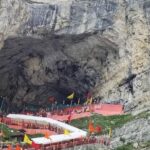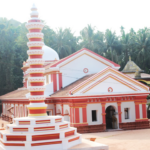Kedarnath is a prominent Hindu pilgrimage site in the Indian state of Uttarakhand, located in the Himalayas at an elevation of around 3,583 meters (11,755 feet). It is one of the most revered temples dedicated to Lord Shiva and is part of the Char Dham Yatra, a sacred journey to four temples in Uttarakhand (Badrinath, Kedarnath, Gangotri, and Yamunotri). The temple is located near the Mandakini River and is surrounded by majestic snow-capped peaks, including the Kedarnath range. Below is a detailed overview of its history, mythology, significance, and key facts.
History of Kedarnath
- Ancient Roots: Kedarnath’s history is rooted deeply in Hindu mythology. While the exact date of its establishment is unclear, it is believed that the temple has existed for over a thousand years. Some suggest that the Pandavas from the Mahabharata built the original structure, while the current temple was built by Adi Shankaracharya, an 8th-century philosopher and theologian, to revive the Hindu tradition.
- Architecture: The temple is constructed in the traditional Himalayan style using large, heavy stones. The sanctum contains a pyramid-shaped rock representing the hump of Lord Shiva, which is worshipped as the main deity. Despite its harsh location and several natural calamities, including devastating floods and earthquakes, the temple has survived and continues to draw pilgrims from all over the world.
- Historical Records: Ancient texts and inscriptions, including references in the Skanda Purana, mention Kedarnath as a key pilgrimage site. It has been a place of worship for thousands of years, with kings, emperors, and spiritual leaders visiting it for blessings.
Mythological Significance
The legend of Kedarnath is deeply tied to the Mahabharata and Lord Shiva:
- Pandavas and Lord Shiva: After the great war of Kurukshetra, the Pandavas sought to atone for the sins of killing their kin and causing massive destruction. Lord Shiva, however, was not willing to grant them an audience. He disguised himself as a bull and wandered into the Garhwal Himalayas. The Pandavas recognized him, and Bhima (one of the Pandavas) tried to catch him, but Shiva disappeared into the ground. It is said that different parts of Shiva’s body appeared in various places, which are now known as the Panch Kedar temples. Kedarnath is where the hump of the bull (Shiva) appeared.
- Adi Shankaracharya’s Contribution: Adi Shankaracharya is credited with reviving the temple in the 8th century. According to legend, after establishing the temple, he attained moksha (liberation) near Kedarnath, and his samadhi (tomb) is located behind the temple.
Religious Significance
- One of the 12 Jyotirlingas: Kedarnath is one of the 12 Jyotirlingas, which are highly revered manifestations of Lord Shiva. Pilgrims believe that visiting this temple, especially after undertaking a strenuous trek, purifies the soul and leads to salvation.
- Part of Char Dham and Panch Kedar: Kedarnath is part of the Char Dham Yatra in Uttarakhand and the Panch Kedar pilgrimage. The Char Dham is a set of four sacred temples (Badrinath, Kedarnath, Gangotri, and Yamunotri), while the Panch Kedar includes Kedarnath, Tungnath, Rudranath, Madhyamaheshwar, and Kalpeshwar. Visiting these temples is considered a spiritually transformative journey.
Geography and Access
Kedarnath is located in the Rudraprayag district of Uttarakhand and lies amidst the Garhwal Himalayan range. The nearest road head is Gaurikund, and from there, pilgrims have to trek 16 kilometers (about 10 miles) to reach the temple.
- Kedarnath Range: The temple is situated at the base of the Kedarnath range, with Mount Kedarnath (6,940 meters) towering above.
- Trek to Kedarnath: Traditionally, the trek to Kedarnath is considered an essential part of the pilgrimage, symbolizing a journey of faith and penance. Due to the high altitude and remote location, the trek is demanding and takes pilgrims through scenic, yet challenging, mountain landscapes.
Natural Disasters and Resilience
- 2013 Kedarnath Flood: One of the most devastating natural disasters in recent history occurred in June 2013, when the region experienced catastrophic floods and landslides due to a cloudburst. A massive surge of water and debris swept through the Kedarnath valley, destroying buildings, homes, and killing thousands of people. Miraculously, the Kedarnath Temple remained largely intact, though its surroundings were severely damaged.
- Reconstruction Efforts: After the disaster, the government of India and several non-governmental organizations worked together to rebuild the infrastructure and restore access to the temple. A new helipad, widened trekking paths, and improved safety measures were put in place to ensure the safety of pilgrims.
Temple Architecture
The Kedarnath Temple is an exemplary piece of ancient architecture, built in stone without any mortar. The walls of the temple depict mythological scenes and figures from Hindu scriptures. The inner sanctum houses a black stone lingam, which is the primary focus of worship. The exterior of the temple has inscriptions and carvings of Hindu deities, and it has survived centuries of extreme weather and seismic activity.
Pilgrimage Season
- Best Time to Visit: The temple remains open only for about six months of the year, from April/May to November (Akshaya Tritiya to Kartik Purnima), due to heavy snowfall during the winter months. During the winter, the deity is moved to Ukhimath, where worship continues.
- Winter Kedarnath: In winter, the entire region is buried under thick snow, making it impossible for pilgrims to access the temple. The idol of Lord Shiva is kept at Omkareshwar Temple in Ukhimath during this period.
Current Access and Facilities
- Helicopter Services: Helicopter services are available from places like Phata and Guptkashi, providing a quicker alternative for pilgrims who cannot undertake the arduous trek.
- Government Initiatives: Post the 2013 floods, the Uttarakhand government has improved infrastructure to Kedarnath by installing better trekking paths, shelters, and medical facilities along the route.
Spiritual Importance
For Hindus, a pilgrimage to Kedarnath is considered one of the most sacred acts of devotion. It is believed that visiting Kedarnath and offering prayers at the shrine can cleanse one’s sins, lead to moksha, and grant divine blessings. The difficult journey symbolizes the hardships faced in spiritual life and the ultimate reward of divine grace.
Conclusion
Kedarnath stands not only as a significant religious symbol but also as a testament to the enduring resilience of spirituality. Despite its remote and challenging location, it attracts thousands of pilgrims every year, embodying the rich tapestry of Hindu beliefs, culture, and mythology. Its connection to both mythology and history, along with the natural beauty of the region, makes Kedarnath one of the most revered pilgrimage sites in India.













